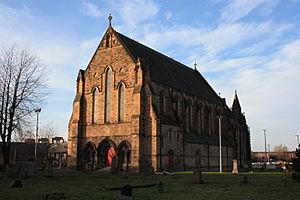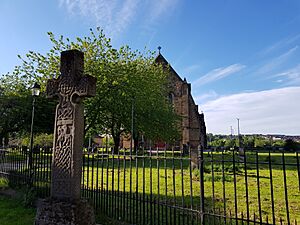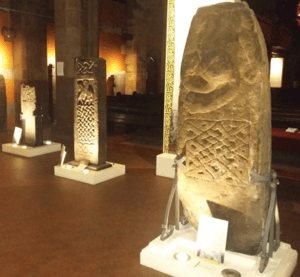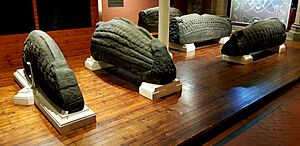Govan Old Parish Church facts for kids
Quick facts for kids Govan Old Parish Church |
|
|---|---|
| The Parish Church of St Constantine of Strathclyde | |
 |
|
| 55°51′53″N 4°18′46″W / 55.8646°N 4.3129°W | |
| Location | Glasgow |
| Country | Scotland |
| Denomination | Church of Scotland |
| Website | https://thegovanstones.org.uk/ |
| History | |
| Status | Closed |
| Founded | c.5th to 6th Century |
| Dedication | Constantine of Strathclyde |
| Dedicated | 19 May 1888 |
| Architecture | |
| Functional status | Museum & Historic Church |
| Architect(s) | Robert Rowand Anderson |
| Years built | 1884-1888 |
| Groundbreaking | 6 December 1884 |
| Closed | October 2007 |
| Administration | |
| Parish | Govan & Linthouse |
| Presbytery | Presbytery of Glasgow |
Govan Old Parish Church is a very old and important building in Govan, a part of Glasgow, Scotland. It was a church from around the 5th or 6th century AD until 2007. In 2007, it stopped being a regular church for Sunday services.
Today, Govan Old is a special place that is both a historic church and a museum. It is open to visitors in the afternoons and still holds a short morning service each day. The church building is dedicated to a saint named Constantine. It is a beautiful example of Scottish Gothic Revival style.
The church is famous for its amazing collection of ancient stone carvings, known as the Govan Stones. These stones were found in the churchyard and are very important for understanding early Scottish history. They include a large stone coffin called the Govan Sarcophagus, tall crosses with detailed carvings, and unique "hogback" stones that look like houses. These stones are from the 9th to 11th centuries AD.
Contents
Govan's Ancient History
It is thought that people first started worshipping here as Christians around the 5th or 6th century AD. Digs in the 1990s found two very old Christian burials under the church. These burials date back to between 435 AD and 601 AD.
Govan became very important in the 9th and 10th centuries. Before that, there are not many records about Govan. However, one old book from the 12th century mentions a place called 'Ovania' when an army returned from attacking Dumbarton Rock in 756 AD.
For a long time, Dumbarton Rock was the main place for the Brittonic Kingdom of Alt Clud (also known as the Kingdom of Strathclyde). But in 870 AD, Vikings attacked Dumbarton Rock. After this, the kings of Alt Clud were no longer mentioned there. Instead, in 872 AD, records talk about the kingdom of Ystrad Clud, which is the Kingdom of Strathclyde. This suggests that the main power moved from Dumbarton Rock to Govan.
Govan might have become important because of a royal estate nearby and a place called Doomster Hill. Doomster Hill was likely a meeting place, similar to a Viking 'thing' site. It might have been built on an old Bronze Age burial mound.
The large size of the churchyard and the many ancient stone carvings show that kings or powerful people supported the church. Because the site has been used continuously for so long, we don't know what the very first church looked like. But it has always been a Christian place.
The Church Building Over Time
Archaeological digs have shown that many churches have been built on this spot over the centuries. We don't know much about the earliest churches. However, we know that a medieval church had a bell tower and was made bigger in 1651. Its old foundations were found during digs between 1994 and 1996.
This medieval church was taken down in 1762, and a new one was built. Then, in 1826, that 18th-century church was replaced with another new one in the Georgian Gothic style. This 1826 building was moved in 1884 to another street and became Elder Park Parish Church. That church closed in 1970 and was taken down in 2008 after a fire.
The Govan Old Parish Church you see today is a beautiful and important building. It was designed by Robert Rowand Anderson and was inspired by Pluscarden Abbey. Most of the current church was built between 1884 and 1888. It was officially opened on May 19, 1888.
Interestingly, the church was built facing north-south instead of the usual east-west. This allowed the main door to face south towards the main street. The church also has lovely stained glass windows. Two of these windows, showing "Emmaus" and "Christ blessing the children," were made by Heaton, Butler and Bayne.
The Govan Stones Museum
The collection of ancient Christian carvings inside the church, known as the Govan Stones, is very important worldwide. People first truly understood their importance in December 1855. This was when a large stone coffin, the Govan Sarcophagus, was found while digging a grave.
This exciting discovery made scholars want to draw and record the Govan Sarcophagus and other ancient stones. A photographer named John Stirling Maxwell took pictures of 46 carved stones. Plaster copies were made of each stone and then photographed in perfect light to show off the carvings. These photos were used in a famous book about early Christian monuments.
In the 1960s, a scholar named Ralegh Radford saw that the Govan Stones could help us understand Govan's early importance. He noticed that the carvings from Govan were similar to others nearby. He called this style the 'Govan School' of carving.
Today, 30 of these amazing monuments are on display inside the church. One more ancient stone remains in the churchyard. Some stones that were not brought inside were thought to be lost or buried after a factory building was taken down in 1973. However, a recent community archaeology dig found at least three of these "lost" stones!
The 31 monuments on display at Govan Old include one sarcophagus (stone coffin), two cross-shafts (parts of crosses), two upright cross-slabs, five "hogbacks" (stones shaped like houses), and 21 flat cross-slabs.
The Govan Old Church and the Govan Stones museum are open every day from April 1 to October 31, from 1 PM to 4 PM. If you want to visit outside these times, you can contact the museum to arrange a tour. Entry to the museum is free, but visitors can make donations. There is also a small gift shop that sells books and local crafts. The money raised helps to look after the church and its collections.
Becoming a Museum
In 2007, the Church of Scotland decided to combine three local churches in the Govan area. Govan Old Church, along with two others, became part of the Govan and Linthouse parish. This meant Govan Old was no longer needed for regular Sunday services.
After 2007, the future of Govan Old Parish Church was uncertain. In 2008, a study was done to figure out what could be done with the building. Funding was secured in 2011 to redesign the display of the stone carvings, which was finished in 2013. Govan Old's future became secure in 2016 when the Govan Heritage Trust received a grant from the Scottish Government.
The Trust wants to turn the church into a self-supporting cultural center, museum, and business complex run by the community. They are still working to get more money to make this happen.
The church is located close to Govan Station on the Glasgow Subway. Its main entrance is next to the Govan War Memorial, which is just west of the Pearce Institute on Govan Road.
Archaeological Discoveries
The TV show Time Team, which is about archaeology, dug in the graveyard of Govan Old Parish Church in 1996. This episode was shown in early 1997.
In March 2019, community archaeologists working with a schoolboy named Mark McGettigan found some medieval stone carvings that had been lost for a long time. People thought these stones had been destroyed by accident when a nearby factory building was taken down in the 1970s.
Professor Stephen Driscoll said, "This is the most exciting discovery we have had at Govan in the last 20 years. The Govan Stones are a collection of international importance and these recovered stones reinforce the case for regarding Govan as a major early medieval centre of power."
Notable Ministers
Many important people have served as ministers at Govan Old Parish Church over the centuries. Some of them include:
- Andrew Melville (1577–1580)
- Thomas Smeaton (1580–1584)
- Robert Boyd (university principal) (1615–1621)
- Hugh Binning (1650–1653)
- Very Rev Matthew Leishman (1821–1874), who was minister for an amazing 53 years. He was also the leader of the Church of Scotland in 1858.
- George MacLeod (1930–1938), who later started the Iona Community.
- David Orr (1960–1980), who helped create the Govan Housing Association.
- Tom Davidson Kelly (1989–2002), who helped bring attention to the ancient stone carvings.
- Moyna McGlynn (2008–2016), who helped look after the building after it closed and supported the old church community.
See also




